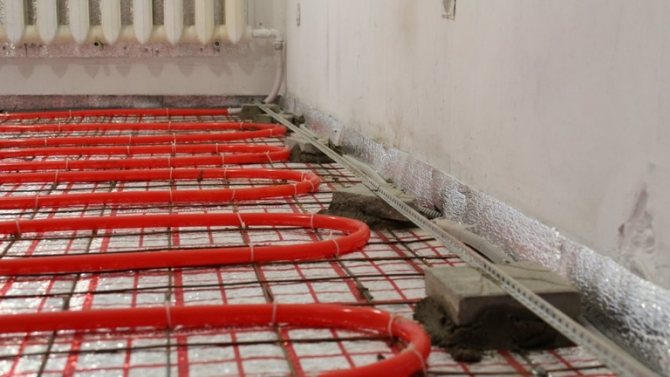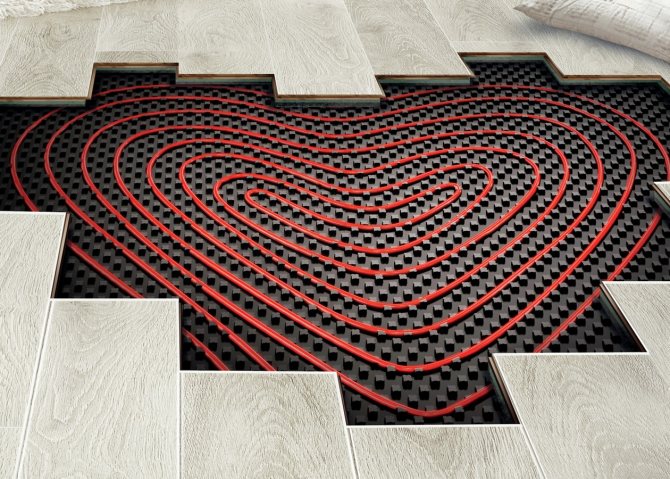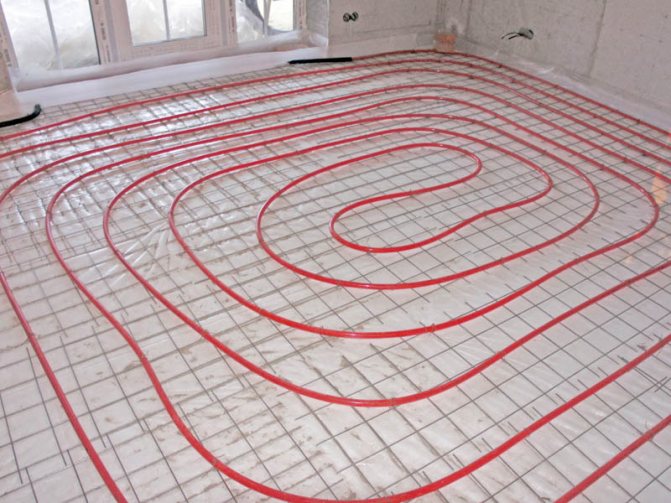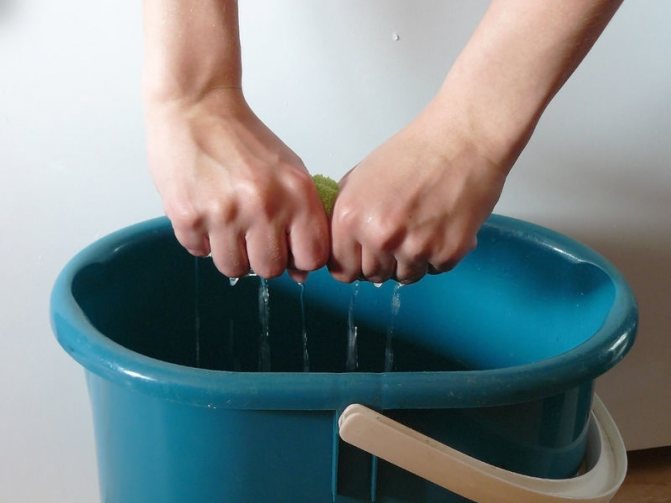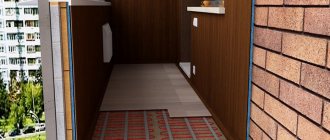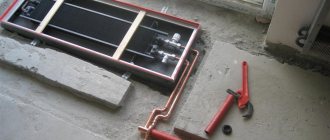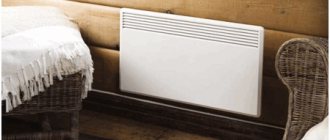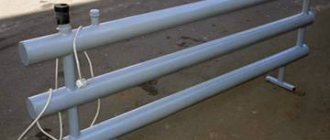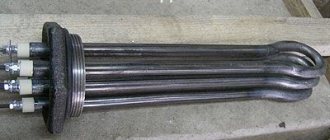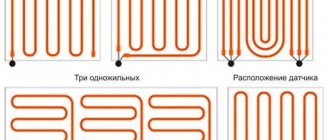The warm floor in the apartment makes it more comfortable, cozy, but the installation of such structures requires a permit.
There are two types of underfloor heating - electric and water. Installing any type of such heating is equivalent to redevelopment, which can affect the climate in neighbors. Due to the warm electric floor, there may be changes in the electrical network in neighboring apartments, and the water heated floor reduces the temperature in the neighbors' batteries. Of course, the housing inspection, called by the tenants, will immediately make claims to the owners of such floors, even if they are not to blame for the decrease in power or temperature, but without permission it threatens with dismantling and a fine. In order not to cause unnecessary trouble and trouble for yourself and your neighbors, you must first coordinate the installation of a warm floor with the relevant authorities.
The device of such a floor is not included in the list of prohibited ones, and it is also not on the list of mandatory approval. However, if underfloor heating is installed in an apartment located in a house with insufficient electrical power, problems remain. This category includes all houses, except for new buildings.
In the old days, houses were built with a power grid designed for a minimum number of electrical appliances, and the old wiring does not withstand the use of modern appliances, including the use of an electric floor. For underfloor heating, it is necessary to replace the wiring and the distribution board.
The housing inspectorate must provide a certificate of the power of the device, confirming that the warm floor will not cause overloads in the network. Such a certificate will remove responsibility in case of any problems with the electrical network. Such a certificate must be obtained from the management company serving the house where this redevelopment is planned.
If there is not enough power, the electric floor cannot be installed. New buildings have a significant power reserve, it is easier to legalize warm electric floors there.
Warm floors from central heating in the apartment fine
However, apartment owners have to face a number of problems when laying this type of heating. First of all, it is necessary to inform the management company of the house about your desire to carry out additional heating. A special permit for the installation of underfloor heating is issued by this very administrative body. Illegal bumping into central heating is being tracked.
If a violation is found, heavy fines are imposed. It is possible to make a warm floor only with the consent of the administration of the house.
It is very difficult to obtain this document. The consent of the parties depends on many factors.
The central heating system is calculated without a large margin for unauthorized connections.
If this is only one apartment, then this will not affect the consumption and overall operation of the heating. But there are many who want to connect a warm floor in a multi-storey building.
In this regard, there is a threat of failure of the entire central highway.
Self-installation of a water-heated floor in an apartment
Therefore, before arranging a water-heated floor in an apartment with your own hands or with the help of involved builders, you must first calculate all the advantages and disadvantages of the solution, take into account the possible risks and negative consequences. According to SNiP, it is possible to make changes to the heating system of the apartment, subject to the approval of the modification with representatives of housing and communal services and heating systems.
In practice, this is possible only in the case of autonomous heating, provided for in the project documentation. There are three main disadvantages of a water-heated floor in an apartment:
- The consequences of possible leaks, the responsibility for which lies entirely with the owner of the apartment.
- Difficulties associated with registration and legalization of the work performed.
- Responsibility for inconsistent installation.
To install warm water floors, you will need to overcome all these difficulties. Decoration - reasons why in apartments
However, if underfloor heating is installed in an apartment located in a house with insufficient, problems remain. This category includes all houses, except for new buildings.
In the old days, houses were built with a power grid designed for a minimum number of electrical appliances, and the old wiring does not withstand the use of modern appliances, including the use of an electric floor.
For underfloor heating, it is necessary to replace the wiring and the distribution board. The housing inspectorate must provide a certificate of the power of the device, confirming that the warm floor will not cause overloads in the network.
Such a certificate will remove responsibility in case of any problems with the electrical network.
Output
Considering that most of the apartments have neighbors on all sides, and only the front wall goes out onto the street, it is safe to say that there is enough water floor heating for the apartment with a margin. Radiators can be dispensed with. Water underfloor heating is a low-temperature heating system. Just in most residential buildings, the temperature regime is not observed. For example, radiators are designed to supply 75 degrees, but in fact 60 degrees come in, respectively, the device cannot give off the required amount of heat. A water-heated floor allows you to compensate for such a drawback, because 35 -40C will be enough for it to supply. Due to its area, it is able to warm up almost any room in a multi-storey building. In corner apartments, residents try to add a radiator to the cold wall of the house. This is a point-to-point solution. Underfloor heating pipes allow you to cut off the cold along the entire length of the wall. Such a solution will allow you to put the cabinet against a cold wall. A water heat-insulated floor in an apartment with stained-glass windows is an ideal solution. By installing automatic heads on the water floor collector, and thermostats in the rooms, you can achieve the ideal microclimate for each room.
Why is there a fine for underfloor heating?
And the connection by residents of an additional source of heat consumption leads to a decrease in the efficiency of the system.
Such a certificate must be obtained from the management company serving the house where this redevelopment is planned. If there is not enough power, the electric floor cannot be installed. New buildings have a significant power reserve, it is easier to legalize warm electric floors there.
In other words, some will be good, while others will not. Also, in the event of a breakthrough of communications in the floor, the neighbors below may suffer from flooding. And you will have to sort things out with them in court. The authorities constantly warn about the responsibility for installing the water circuit, but there are still people who want to install it in their apartment.
Since in our conditions it is almost impossible to obtain official permission for this, many act at their own peril and risk.
We recommend to read: Is it possible to put a car in a paid parking lot at night without paying
If no one finds out, then maybe it will be bypassed. The official design of an autonomous water heating system presupposes that at least two conditions are met: After installing the underfloor heating, the total power must remain unchanged. But for this it is necessary to reduce the number of heating batteries in the rooms, and this is not always acceptable.
Underfloor heating fines
Heating in the house is done according to the project, the flow rate of the coolant is calculated depending on the number of batteries, pipe diameters, on the materials of walls and floors, on the region where the house is located, and much more. Those. as much coolant is supplied to your house as provided by the project.
If you make a warm floor, you will take more coolant for yourself than the project provides, but exactly what is supposed to be supplied to the house, which means that you are taking heat from the neighbors. Hence the complaints of neighbors about the sudden drop in temperature in the apartments, followed by visits first by representatives of the ZhEK, then by the Housing Inspectorate, a fine, a court, a decision to bring everything that was put into the state that was before your intervention at your expense, of course.
Please note that in some cases, if your actions pose a danger to all residents of the house, they can knock the door into the apartment without your consent.
Underfloor heating from central heating in the apartment
If detected, the owner of the apartment faces an administrative fine.
Why underfloor heating from central heating is impractical: Inserting a warm floor into an existing system leads to a violation of the temperature balance of the entire riser.
If this happens on the upper floors, the "loss of degrees" may not be noticeable, but from the middle of the house it will become critical. Underfloor pipes are a potential risk of accidents.
If damaged, it will flood all downstream apartments. It will not work to get a high temperature of the coolant in the system, precisely because of the total supply to the riser.
In winter, such floors will be slightly warm, and during the off-season, when the heating has not yet been turned on or has already been turned off, there is no sense at all in such a system. The quality and purity of the coolant in the central pipeline has always left much to be desired. Since the maximum pipe diameter for TP does not exceed
Wiring diagrams of water underfloor heating to central heating
The connection diagram of a water-heated floor to the central heating system can be made on the first floors with the upper wiring. In this case, heat will not be taken away from the residents of the upper floors.
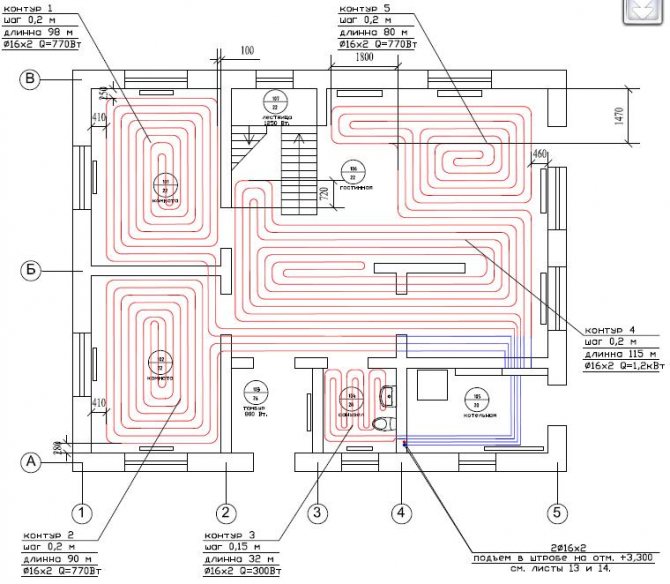
Connection to risers can be made using three - and four-way mixing taps. The temperature of the coolant in the central heating system can exceed 90C, which is unacceptable for supply to a water-heated floor. The mixing unit is responsible for reducing the temperature in the water floors. A prerequisite for durable work is the installation of mud collectors. It is better to place them in a place convenient for servicing. In central heating systems, as a rule, there is a rather dirty coolant, and large particles can clog the pipes of the underfloor heating over time, so flushing will be required. You will also need to install a circulation pump. The hydraulic resistance in the branches of underfloor heating may be sufficient, which will not allow the central heating system to push through them. A circulating pump can handle this task. The second point - if the system is made without a circulation pump, then when the mixing valve is completely closed, the circulation in the warm floors will stop. Warming up may be uneven. Below are the typical schemes for the assembly of pump-mixing units
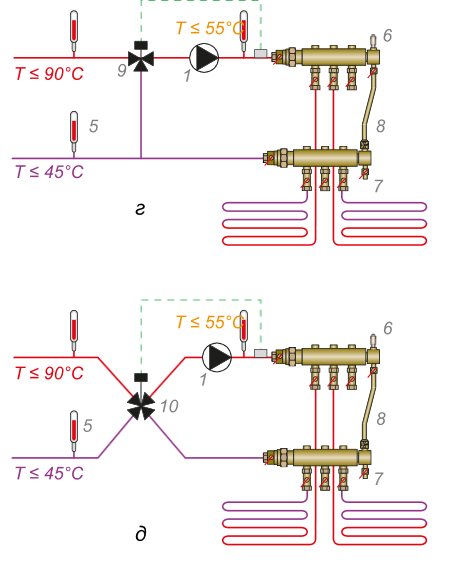

A practical solution is also a circuit with an intermediate heat exchanger (fig. "E"). From our point of view, this is an ideal option, since the apartment heating system with underfloor heating becomes autonomous. The pressure in the system will not exceed 3 atmospheres. Having filled in the coolant once, it will only be necessary to recharge it sometimes. In the event of a leak under the screed, you will not flood your neighbors, because there is very little water in one branch of the heated floor. The heat exchanger can be easily removed and washed.
What is the penalty for warm floors
And if the underfloor heating is planned from the mains, but the house has old wiring, the results will also be disastrous.
Is it possible to install underfloor heating legally There is no direct context, which would contain the amount of the fine for installing underfloor heating. However, there is an article stipulating responsibility for the redevelopment of the premises. In addition, there is a Resolution on the organization of reorganization - PPM 508-PP.
Instead of deliberately violating the law, it is better to try to legalize underfloor heating.
Moreover, it is quite possible, especially in new buildings.
Old buildings have very weak electrical wiring, designed for a small number of electrical appliances.
In order to obtain permission to install a floor heating system, you need to provide the following documents: To carry out an electric floor heating - a certificate on the power of the electrical network in the house and a document on what power the floor heating system will consume;
Warm floors from central heating in the apartment fine
If this system is discovered by competent services, then a large fine is possible. If you decide to install underfloor heating from central heating in an apartment, then you need to study all the available options.
In order to choose the most suitable option for your case. A connection where a direct connection diagram to a heating radiator is used. The most primitive low-power water pump is used.
The simplest and least expensive method, but has very low reliability.
With this method of connection, heating cannot be controlled, and the temperature in the system can drop significantly, which can lead to a disruption in the heat supply of other apartments powered by this riser.
Connecting a water underfloor heating to a radiator Direct connection using a bypass.
Recommended reading: If a grandmother is taking her grandson abroad
Prohibitions
Underfloor heating in an apartment from central heating: is it legal? Yes, but only if we are talking about a new building, the communications of which provide for the possibility of such changes. In the case of houses built earlier, any such interference is, in fact, prohibited. However, practice shows that this rarely stops those who want to live comfortably.
The answer to the question whether it is possible to make underfloor heating from central heating in an apartment largely depends on how much energy is allocated for the apartment. If the structure you are equipping consumes more than it should, the balance may be upset, and the neighbors will not receive their legitimate heat. Such destabilization can be easily eliminated with the help of regulators, but even having a flawless installation scheme does not mean that you can get to work.
So, if you ask whether it is possible to make water-heated floors in an apartment building, you will most likely be rejected. Freelance? Independent intervention in the operation of the heating system is fraught not only with serious penalties, but also with the need to subsequently dismantle the structure. Of course, you can take the risk and live in eternal fear of visiting the supervisory authorities, but do you need it. The law prohibiting the installation of a water heat-insulated floor in an apartment building, in principle, can be circumvented with the help of various bureaucratic tricks. Let's say you managed to agree on the redevelopment in the official instance and negotiate with the neighbors below. This means that you can start implementing the project.
What is the penalty for warm floors
As soon as a new "participant" appears in the system, the load on all heating points changes.
If you think about a possible accident in the underfloor heating system, you can imagine the scale of the disaster for your neighbors.
And if the underfloor heating is planned from the mains, but the house has old wiring, the results will also be disastrous. There is no direct context where the amount of the fine for installing a warm floor would be contained in the legislation.
However, there is an article stipulating responsibility for the redevelopment of the premises. In addition, there is a Resolution on the organization of reorganization - PPM 508-PP. Instead of deliberately violating the law, it is better to try to legalize underfloor heating. Moreover, it is quite possible, especially in new buildings.
Old buildings have very weak electrical wiring, designed for a small number of electrical appliances. In order to obtain permission to install a floor heating system, you need to provide the following documents:
Types of schemes
In the event that a permit is received and all the necessary elements are purchased, you can begin to install a warm floor from heating in an apartment according to one of the schemes:
- The simplest, but not the most reliable, installation option for a water structure is to connect it directly to the battery. This will require:
- valves (inlet, outlet);
- distribution manifolds;
- bypass.
- Water heating of the floor in the apartment with the ability to regulate the heating is installed using a balancing valve. It is placed on the bypass and allows you to reduce the temperature of the coolant supplied to the circuit. An important detail of this diagram is the quality of the circulation pump. Its technical parameters must correspond to the pumping of water from 5 to 10 l / s. with a head up to 2 m.
- A scheme where a three-way valve is used instead of a pump is permissible only in those houses where there is always good water circulation. It is installed in the mixing unit.
In this scheme, the main drawback is the inability to regulate the temperature, which is absolutely unacceptable for underfloor heating systems. Of no less importance is the fact that at the entrance to the system, the temperature can rise to +75 degrees, which not every floor covering will withstand.
The easiest way is to install underfloor heating in an apartment with individual heating, while they can be both the only source of heating and an additional one.
What is the penalty for connecting to underfloor heating
If this system is discovered by competent services, then a large fine is possible.
If you decide to install underfloor heating from central heating in an apartment, then you need to explore all the available options. In order to choose the most suitable option for your case.
- A connection where a direct connection diagram to a heating radiator is applied. The most primitive low-power water pump is used. The simplest and least expensive method, but has very low reliability. With this method of connection, heating cannot be controlled, and the temperature in the system can drop significantly, which can lead to a disruption in the heat supply of other apartments powered by this riser.
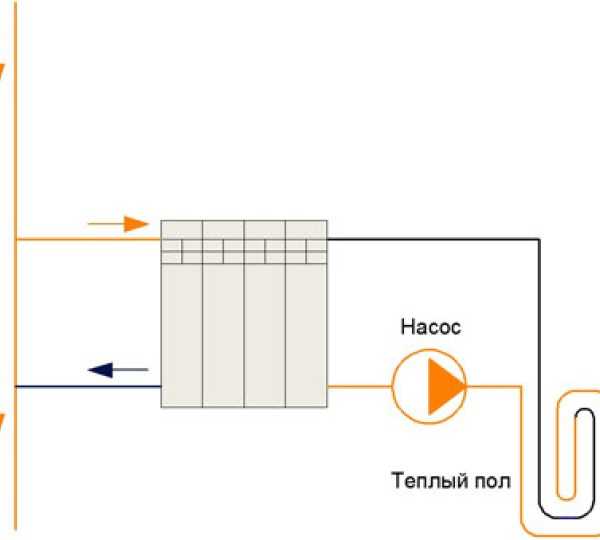

Connecting a water heated floor to a radiator Direct connection using a bypass.
Harmonization
When a technical conclusion is received from the energy supervision or heating networks about the possibility of changing the floor contour, a project is made, which is then agreed upon in the housing inspectorate. To develop a project, you should contact a design organization that has an SRO approval.
After the installation of the floors, it is impossible to inspect the work, therefore the builders fill out the certificates of inspection of the hidden works. These workers must also have an SRO permit. The documents are signed by them and representatives of the design organization. The issued acts are entered into the work production log.
An organization that makes a warm floor in an apartment must be licensed.After the work, the heating operation of the system is tested. Based on the test results, an appropriate act is drawn up. For a water floor, an act of hydraulic testing is required, for an electrical floor, an act of approbation of automation of regulation and protection is required.
General list of documents that must be at the time of installation of the heating system:
- License from the construction organization performing the installation;
- Certificate of survey of hidden works and executive documentation for the installation of heating elements;
- Examination of hydraulic tests;
- Examination of thermal tests.
List of documents required for further operation:
- Drawings, as well as an act of their compliance with the work performed;
- certificate of inspection of hidden works;
- act of thermal testing of heating devices;
- an act of individual testing of automation of regulation and protection.
Everyone knows the delights of the comfort of a warm floor. But the price of a set of electric underfloor heating, and in the future, monthly bills for consumed electricity can somewhat overshadow the pleasure of such comfort. An excellent alternative is a water heat-insulated floor. If the house or apartment has autonomous heating - the practice is already widespread, experience can be gleaned in various articles and reviews. But what if the apartment is located in a multi-storey building with central heating? There is nothing to be done - you need to make a water heat-insulated floor from central heating.
A kitchen and a bathroom were chosen for this experiment. Ceramic tiles are very conducive to the warm floor, especially in winter. So where do you start?
How to legalize water heated floors in an apartment building?
Zhukovsky 289 cost of the questionquestion resolved Minimize Legal advice online Answer on the site within 15 minutes Answers of lawyers (2) received a fee of 56% 8.1 Rating Pravoved.ru 5117 answers 2521 feedback expert Chat in a chat Free assessment of your situation
Syktyvkar Free assessment of your situation
- expert
- 8.1 rating
Hello Vladimir! The first question that arises is: vertical or horizontal wiring of the heating system in your house? Judging by the fact that you wrote that you did not have a heating system in your apartment, I can only assume that the wiring is horizontal, the heat-consuming installations in the apartments have disconnecting devices, which means they are not the common property of the owners of the premises in the house.
In this regard, the heat exchanger installed by you with the transition to underfloor heating simply acts as a radiator, and the common property is not affected in any way.
How to get permission for a warm floor in an apartment
However, if underfloor heating is installed in an apartment located in a house with insufficient electrical power, problems remain. This category includes all houses, except for new buildings.
In the old days, houses were built with a power grid designed for a minimum number of electrical appliances, and the old wiring does not withstand the use of modern appliances, including the use of an electric floor. For underfloor heating, it is necessary to replace the wiring and the distribution board.
The housing inspectorate must provide a certificate of the power of the device, confirming that the warm floor will not cause overloads in the network. Such a certificate will remove responsibility in case of any problems with the electrical network. Such a certificate must be obtained from the management company serving the house where this redevelopment is planned.
If there is not enough power, the electric floor cannot be installed.
Hot water floor heating with electric boiler
If you cannot get attached to the central heating system under any circumstances, you can use a small electric boiler. Of course, the cost of such heating will increase significantly, but
reliability will remain higher than that of electric ones. In the event of a cable burnout, you will have to open the entire cable tie to replace the cable. With electric floors, it is not always possible to change the arrangement of furniture. Water heated floors are not subject to overheating. Maintenance of an electric boiler is much easier and cheaper than replacing the cable in the floor screed. The photo shows an electric boiler for an apartment water floor, created on the basis of an ordinary electric heater for a water heater. The body is made of stainless steel pipe. Such a mini-boiler is easy to maintain, and tens are sold in any city and are always available.

